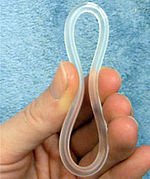
Back حلقة البروجستيرون المهبلية Arabic Anillo vaginal de progesterona Spanish Պրոգեստերոնային հեշտոցային օղ Armenian ପ୍ରୋଜେସ୍ଟିରନ ଯୋନୀପଥ ମୁଦ୍ରିକା OR Vòng âm đạo progesterone Vietnamese 孕酮陰道環 Chinese
| Progesterone vaginal ring | |
|---|---|
 NuvaRing, a similar birth control vaginal ring | |
| Background | |
| Type | Hormonal |
| First use | 1998 |
| Trade names | Progering, Fertiring, others |
| Failure rates (first year) | |
| Perfect use | ? |
| Typical use | 1.5%[1] |
| Usage | |
| Duration effect | 3 months |
| User reminders | ? |
| Advantages and disadvantages | |
| STI protection | No[2] |
| Period advantages | Periods may not occur while ring is inserted |
| Benefits | Easy insertion and removal[3] |
Progesterone vaginal ring, also known as progesterone-only vaginal ring, is a form of vaginal ring used for birth control when breastfeeding.[1] Use can begin at four weeks and continue for at least up to a year following childbirth.[4][3] Failure rates with usual use is about 1.5 per 100 women.[1] It is used within the vagina with one ring lasting three months.[4] The woman is able to place and remove the ring herself.[3] It is sold under the brand names Progering among others.[5]
Side effects include vaginal discharge and pain with urination.[3] It does not appear to be associated with serious side effects.[3][6] With use menstrual periods often do not resume.[1] It was specifically made for use with breastfeeding as it does not affect milk production.[1] It works by gradually releasing the hormone progesterone.[1]
Progesterone vaginal rings have been approved for medical use since 1998.[2] It is on the World Health Organization's List of Essential Medicines.[7][8] As of 2014, they are available in a number of South and Central American countries.[1] As of 2016, it is not available in the United States.[4] It was developed by the Population Council.[5][2]
- ^ a b c d e f g Whitaker, Amy; Gilliam, Melissa (2014). Contraception for Adolescent and Young Adult Women. Springer. p. 98. ISBN 9781461465799. Archived from the original on 2016-12-29.
- ^ a b c "Progesterone Vaginal Ring" (PDF). PATH. Archived (PDF) from the original on 5 November 2017. Retrieved 28 December 2016.
- ^ a b c d e World Health Organization (2015). The selection and use of essential medicines. Twentieth report of the WHO Expert Committee 2015 (including 19th WHO Model List of Essential Medicines and 5th WHO Model List of Essential Medicines for Children). Geneva: World Health Organization. pp. 334–336. hdl:10665/189763. ISBN 9789241209946. ISSN 0512-3054. WHO technical report series;994.
- ^ a b c Greenberg, Jerrold S.; Bruess, Clint E.; Oswalt, Sara B. (2016). Exploring the Dimensions of Human Sexuality. Jones & Bartlett Publishers. ISBN 9781284081541. Archived from the original on 2016-12-28.
- ^ a b "Population Council's Progesterone Contraceptive Vaginal Ring Added to WHO 2015 Essential Medicines List and Included in Medical Eligibility Criteria Guidance for Providers | Population Council". www.popcouncil.org. 9 June 2015. Archived from the original on 29 December 2016. Retrieved 28 December 2016.
- ^ Carr, SL; Gaffield, ME; Dragoman, MV; Phillips, S (September 2016). "Safety of the progesterone-releasing vaginal ring (PVR) among lactating women: A systematic review". Contraception. 94 (3): 253–61. doi:10.1016/j.contraception.2015.04.001. PMID 25869631.
- ^ World Health Organization (2019). World Health Organization model list of essential medicines: 21st list 2019. Geneva: World Health Organization. hdl:10665/325771. WHO/MVP/EMP/IAU/2019.06. License: CC BY-NC-SA 3.0 IGO.
- ^ World Health Organization (2021). World Health Organization model list of essential medicines: 22nd list (2021). Geneva: World Health Organization. hdl:10665/345533. WHO/MHP/HPS/EML/2021.02.